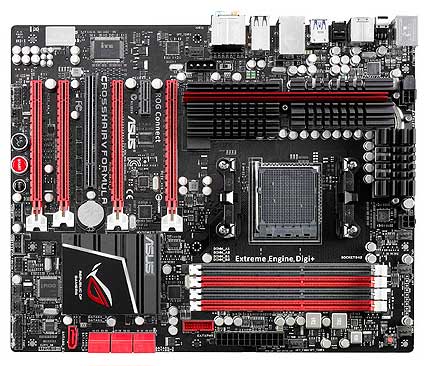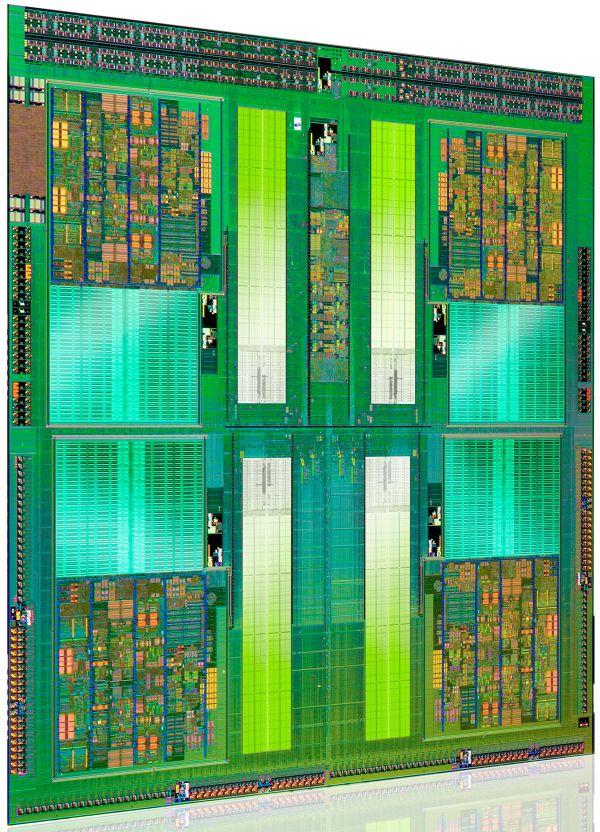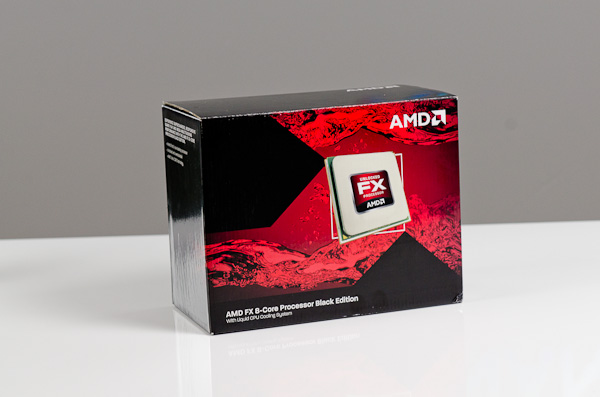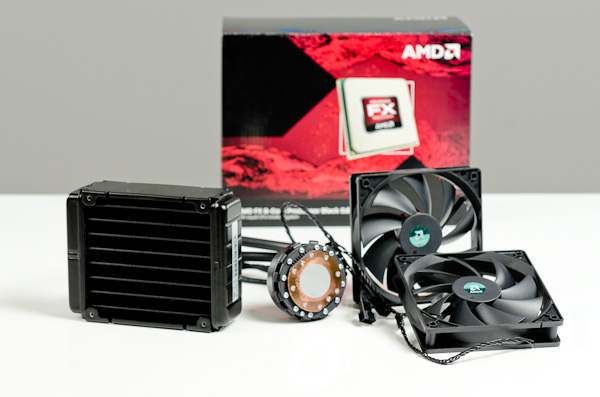The Bulldozer Review: AMD FX-8150 Tested
by Anand Lal Shimpi on October 12, 2011 1:27 AM ESTAMD has been trailing Intel in the x86 performance space for years now. Ever since the introduction of the first Core 2 processors in 2006, AMD hasn't been able to recover and return to the heyday of the Athlon 64 and Athlon 64 X2. Instead the company has remained relevant by driving costs down and competing largely in the sub-$200 microprocessor space. AMD's ability to hold on was largely due to its more-cores-for-less strategy. Thanks to aggressive pricing on its triple and hexa-core parts, for users who needed tons of cores, AMD has been delivering a lot of value over the past couple of years.
Recently however Intel has been able to drive its per-core performance up with Sandy Bridge, where it's becoming increasingly difficult to recommend AMD alternatives with higher core counts. The heavily threaded desktop niche is tough to sell to, particularly when you force users to take a significant hit on single threaded performance in order to achieve value there. For a while now AMD has needed a brand new architecture, something that could lead to dominance in heavily threaded workloads while addressing its deficiencies in lightly threaded consumer workloads. After much waiting, we get that new architecture today. Bulldozer is here.
It's branded the AMD FX processor and it's only available in a single die configuration. Measuring 315mm2 and weighing in at around 2 billion transistors (that's nearly GPU-sized fellas), Bulldozer isn't that much smaller than existing 45nm 6-core Phenom II designs despite being built on Global Foundries' 32nm SOI process. Both die area and transistor count are up significantly over Sandy Bridge, which on Intel's 32nm HKMG process is only 995M transistors with a die size of 216mm2. This is one big chip.
| CPU Specification Comparison | ||||||||
| CPU | Manufacturing Process | Cores | Transistor Count | Die Size | ||||
| AMD Bulldozer 8C | 32nm | 8 | 1.2B* | 315mm2 | ||||
| AMD Thuban 6C | 45nm | 6 | 904M | 346mm2 | ||||
| AMD Deneb 4C | 45nm | 4 | 758M | 258mm2 | ||||
| Intel Gulftown 6C | 32nm | 6 | 1.17B | 240mm2 | ||||
| Intel Nehalem/Bloomfield 4C | 45nm | 4 | 731M | 263mm2 | ||||
| Intel Sandy Bridge 4C | 32nm | 4 | 995M | 216mm2 | ||||
| Intel Lynnfield 4C | 45nm | 4 | 774M | 296mm2 | ||||
| Intel Clarkdale 2C | 32nm | 2 | 384M | 81mm2 | ||||
| Intel Sandy Bridge 2C (GT1) | 32nm | 2 | 504M | 131mm2 | ||||
| Intel Sandy Bridge 2C (GT2) | 32nm | 2 | 624M | 149mm2 | ||||
Update: AMD originally told us Bulldozer was a 2B transistor chip. It has since told us that the 8C Bulldozer is actually 1.2B transistors. The die size is still accurate at 315mm2.
Architecturally Bulldozer is a significant departure from anything we've ever seen before. We'll go into greater detail later on in this piece, but the building block in AMD's latest architecture is the Bulldozer module. Each module features two integer cores and a shared floating point core. FP hardware is larger and used less frequently in desktop (and server workloads), so AMD decided to share it between every two cores rather than offer a 1:1 ratio between int/fp cores on Bulldozer. AMD advertises Bulldozer based FX parts based on the number of integer cores. Thus a two module Bulldozer CPU, has four integer cores (and 2 FP cores) and is thus sold as a quad-core CPU. A four module Bulldozer part with eight integer cores is called an eight-core CPU. There are obvious implications from a performance standpoint, but we'll get to those shortly.
The FX Lineup
There are a total of 7 AMD FX CPUs that AMD is announcing today, although only four are slated for near-term availability.
| CPU Specification Comparison | |||||||||
| Processor | Cores | Clock Speed | Max Turbo | NB Clock | L2 Cache | TDP | Price | ||
| AMD FX-8150 | 8 | 3.6GHz | 4.2GHz | 2.2GHz | 8MB | 125W | $245 | ||
| AMD FX-8120 | 8 | 3.1GHz | 4.0GHz | 2.2GHz | 8MB | 95W/125W | $205 | ||
| AMD FX-8100* | 8 | 2.8GHz | 3.7GHz | 2GHz | 8MB | 95W | N/A | ||
| AMD FX-6100 | 6 | 3.3GHz | 3.9GHz | 2GHz | 6MB | 95W | $165 | ||
| AMD FX-4170* | 4 | 4.2GHz | 4.3GHz | 2.2GHz | 4MB | 125W | N/A | ||
| AMD FX-B4150* | 4 | 3.8GHz | 4GHz | 2.2GHz | 4MB | 95W | N/A | ||
| AMD FX-4100 | 4 | 3.6GHz | 3.8GHz | 2GHz | 4MB | 95W | $115 | ||
| AMD Phenom II X6 1100T | 6 | 3.2GHz | 3.6GHz | 2GHz | 3MB | 125W | $190 | ||
| AMD Phenom II X4 980 | 4 | 3.7GHz | N/A | 2GHz | 2MB | 125W | $170 | ||
The FX-8150, 8120, 6100 and 4100 are what's launching today. The first digit in AMD's FX model numbers indicates the number of cores with the 8150 and 8120 boasting eight, while the 6100 only has six active integer cores (three Bulldozer modules). The FX-4100 features four integer cores. L2 cache scales with core count (2MB per module), while the L3 cache size remains fixed at 8MB regardless of SKU.
North Bridge and L3 cache frequency alternate between 2.0GHz and 2.2GHz depending on the part. TDPs range between 95W and 125W as well, with the FX-8120 being offered in both 125W and 95W versions.
There's only a single Bulldozer die. The 6 and 4 core versions simply feature cores disabled on the die. AMD insists this time around, core unlocking won't be possible on these harvested parts.
The huge gap in clock speed between the 8120 and 8150 are troubling. Typically we see linear frequency graduations but the fact that there's a 16% difference between these two SKUs seems to point to process problems limiting yield at higher frequencies—at least for the 8-core version.
Outside of the quad-core and hex-core Bulldozer pats, the only other FX processor able to exceed the 3.3GHz clock speed of the Phenom II X6 1100T is the 8150. And if you include quad-core Phenom II parts in the mix, only two Bulldozer parts ship at a higher stock frequency than the Phenom II X4 980. Granted Turbo Core will help push frequencies even higher, but these low base frequencies are troubling. For an architecture that was designed to scale to clock speeds 30% higher than its predecessor, Bulldozer doesn't seem to be coming anywhere close.
The entire FX lineup ships unlocked, which allows for some easy overclocking as you'll see soon enough.
Motherboard Compatibility
AMD is certifying its FX processors for use on Socket-AM3+ motherboards. Owners of standard AM3 motherboards may be out of luck, although motherboard manufacturers can choose to certify their boards for use with Bulldozer if they wish to do so. From AMD's perspective however, only AM3+ motherboards with BIOS/UEFI support for Bulldozer are officially supported.
All existing AM2/AM2+/AM3/AM3+ heatsinks should work with the FX processor; they simply need to be rated for the TDP of the processor you're looking to cool.

For this review, AMD supplied us with ASUS' Crosshair V Formula AM3+ motherboard based on AMD's 990FX chipset.
AMD does offer six 6Gbps SATA ports on its 990FX chipset, a significant upgrade from the two 6Gbps ports on Intel's 6-series chipsets. Unbuffered ECC memory is also supported for those who desire the added security, once again a feature not supported on Intel's consumer grade 6-series chipsets.
Despite AMD's trend towards releasing APUs with integrated GPUs (thus requiring a new socket), AMD insists that the AM3+ platform will live to see one more processor generation before it's retired.
AMD's Liquid CPU Cooling System
Alongside its new FX processors AMD is introducing its first branded liquid cooling system manufactured by Asetek.
AMD's cooling system is similar to other offerings from companies like Antec and Corsair. The system is self contained, you never have to worry about adding any more liquid to it.
Attach the cooling module to your CPU socket via a simple bracket, and affix the radiator to your case and you're good to go. The radiator is cooled via two 120mm fans, also included in the box.
AMD doesn't have an exact idea on pricing or availability of its liquid cooling solution, but I'm told to expect it to be around $100 once available. My sample actually arrived less than 12 hours ago, so expect a follow up with performance analysis later this week.
The Roadmap
For the first time in far too long, AMD is actually being very forthcoming about its future plans. At a recent tech day about Bulldozer, AMD laid out its CPU core roadmap through 2014. The code names are below:
Piledriver you already know about, it's at the heart of Trinity, which is the 2—4 core APU due out in early 2012. Piledriver will increase CPU core performance by around 10—15% over Bulldozer, although it will initially appear in a lower performance segment. Remember that final generation of AM3+ CPU I mentioned earlier? I fully expect that to be a GPU-less Piledriver CPU due out sometime in 2012.
Steamroller will follow in 2013, again improving performance (at the core level) by around 10—15%. Excavator will do the same in 2014. AMD believes that these performance increases will be sufficient to keep up with Intel over time, however I'll let you be the judge of that once we get to the Bulldozer performance numbers.
The other thing to note about AMD's roadmap is it effectively puts the x86 business on an annual cadence, in line with what we've seen from the AMD GPU folks. Although AMD isn't talking about what process nodes to expect all of these cores at, it looks like AMD will finally have an answer to Intel's tick-tock release schedule moving forward.























430 Comments
View All Comments
B3an - Wednesday, October 12, 2011 - link
Yep this really is extremely disappointing. I'm actually going to call this AMD's Pentium 4. Thats how bad this is.2 billion transistors - thats a massive increase over the Phenom II X6 and what do we get? Nothing. The Phenom II is atleast as good with WAY less transistors and lower power consumption under load. I'm pretty shocked at how bad Bulldozer is. I wasn't expecting performance clock for clock to be as good as Nehalem, let alone Sandy Bridge, but this is just... appalling. When Ivy Bridge is out the performance difference is going to be MASSIVE.
Intel are surely going to implement more restrictions and hold there clocks speeds back even further. Theres just no competition anymore. Sad day for consumers.
bennyg - Wednesday, October 12, 2011 - link
AMD's Prescott to be exact... ironically that's one thing they seemed to shoot for in deepening pipeline and hoping that process would be better... hopefully this is just immature and soon there will be a GF110-style refresh that does it properly...Otherwise the whole next gen of AMD CPUs will continue to fight for scraps at the bottom of the heap... and their laptop CPUs will not even succeed there.
TekDemon - Wednesday, October 12, 2011 - link
I don't even know if it's just the process since those power consumption figures seem to suggest that they're being limited by the sheer amount of power it's using and the heat being generated from that. Intel had planned to take the P4 to 10Ghz but the fact that it was a power hog prevented that from realistically happening and it seems like you have the same issue here. The clockspeed potential is clearly there since it can hit 7Ghz under liquid nitrogen but for a normal air heatsink setup this is a recipe for failure. It's just way too power hungry and not fast enough to justify it. Why would anybody choose to use an extra 100 watts for largely the same or worse performance vs an i5 2500K?Thermalzeal - Wednesday, October 12, 2011 - link
I agree, 2 billion transistors are doing what exactly?The worst thing is that the water cooler isn't included with the FX-8150. At the performance levels they are providing, they should have just upped the price 30-50 bucks and provided the cooler gratis. Who's gonna need an AMD branded cooler if their not going to buy bulldozer?
The other point of these review is that there is no availability of any of the parts. So what a wonderful paper launch we have here. Seems like AMD isn't betting on anyone being interested enough to buy one of these things.
Blasphemy.
eanazag - Wednesday, October 12, 2011 - link
You can find them on Newegg today. The price is jacked up though. Newegg must not read AT.jleach1 - Friday, October 21, 2011 - link
Sigh...it's quite sad. There must be actual people buying these...either that or the supply is terrible. Because there's no way in hell i'd pay those prices for an AMD processor.defacer - Wednesday, October 12, 2011 - link
Like most people here, I 'm disappointed with BD performance -- even though I have never owned an AMD CPU after my 386DX/40 myself, competition in the performance segment would be nice for a change.I won't argue against "it's not 8 core", but calling it a 4-core is IMHO just as inappropriate (if not more).
yankeeDDL - Wednesday, October 12, 2011 - link
Ok, how about 4 modules, with 8 integer EU, 4 fetch, 4 decode, 4 L2 caches ...Point being, they are 4 modules, not 8 cores, and from many aspects, they are more similar to a 4-core CPU than to an 8-core CPU, being neither one (somewhere in between).
The fact of the matter remains: the IPC is bad. In multi-threaded, Integer-intensive tasks, BD should crunch the PhenomII X6 (2 more cores, higher clock speed), but it seems you can hardly see the difference. (ref: Excel 2007 SP! MonteCarlo sims).
AMD now is left with Llano as the only compelling reason to buy AMD over Intel (for netbooks and small notebooks, where Atom is the contender).
Against Core, either the FX-8150 goes down to $200 or less, or the i5-2500 is just a better buy for the money.
The advantage is I don't need a new MoBo (huge advantage for me, but not very compelling, in general).
yankeeDDL - Wednesday, October 12, 2011 - link
Forgot to mention, regarding the integer-intensive test: the core-i5 is slower by about 9% slower with 9% slower clock, but only 4 execution units (8 logical, with hyperthreading, but hyperthreading should be nearly irrelevant in this test).What a blow.
Ratman6161 - Wednesday, October 12, 2011 - link
We can argue about weather its really a 4 core or an 8 core, and the argument is interesting from a technical standpoint. But the proof is in the real world benchmarks. From a practical standpoint, if the benchmarks are not there (and they aren't) then the rest really doesn't matter.I looked on Microcenter where you can get a 2600K for $279 and a 2500K for $179. An i5-2400 is only $149. So AMD is going to be right back to having to cut prices and have its top end CPU go up against $149 - $179 Intel parts. Worse yet, it will, at least initially, be competing against its own previous generation parts.
There is one point of interest though and that is the fact that all the FX's are unlocked (according to the story). So it's pretty likely that an FX 8100 will probably overclock about as high as an 8150 once the process is mature. But there again, among overclockers, AMD could find its highest end 8150 competing against its own lower priced 8100.
Back in the day, I loved my Athlon 64's and 64 x2's and even though I have switched to an Intel Q6600 and then a 2600K, I still really want AMD to succeed...but its not looking good.